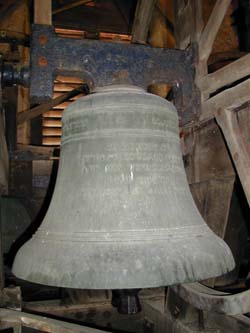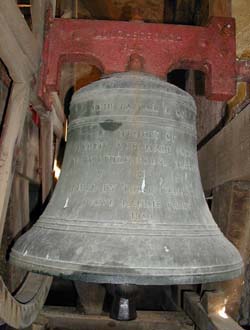From the Thorley Archives
St James the Great Church Bells

 Our bell tower contains six bells, three of
which date back to the 17th century. Two more were added in 1937
in memory of the Proctor and Frere families when all five bells
were adapted for full circle ringing, the original three being
set up for chime ringing. A sixth treble bell was added in 1946.
The total weight of the 6 bells is over 1 ton safely installed on
a massive oak frame. The bells are rung from the ringing floor
above the west entrance to the church and two storeys below the
bell chamber.
Our bell tower contains six bells, three of
which date back to the 17th century. Two more were added in 1937
in memory of the Proctor and Frere families when all five bells
were adapted for full circle ringing, the original three being
set up for chime ringing. A sixth treble bell was added in 1946.
The total weight of the 6 bells is over 1 ton safely installed on
a massive oak frame. The bells are rung from the ringing floor
above the west entrance to the church and two storeys below the
bell chamber.
Besides the regular Sunday ringing and the
special services (weddings, Christmas and New Year) notable
occasions are commemorated by longer peals that can take up to 3
hours. A 'Notable Ring' marked the Rev. Clive Slaughter's
retirement in October 2001 whilst in November 1999 a 'Full Peal'
was rung at Tom Camp's funeral. Other historic national events
such as King George VI funeral, Winston Churchill's funeral and
Prince Charles and Lady Diana's wedding have been were remembered
in this way. Such significant ringing events are noted on peal
boards in the ringing chamber.
The bells require regular maintenance to ensure
their safe and smooth running and the church is indebted to Frank
Kirby in his dual capacity as tower captain and steeple keeper.
His service schedules include monthly inspections of all
mechanical parts, 6 weekly greasing of the bearings, 6 monthly
lubricating of the ropes to seal in their natural oils and annual
lubrication of the inside washers of the bells. As tower captain
he is responsible for organising attendance for the ringing
occasions and practices. He also promotes liaison with other bell
ringing communities, notably Standon and St Mary's, Stansted. Ken
Newstead is the ringing master who conducts the ringers.
The bells of St. James the Great have played a
significant part in the life of the parish for nearly 400 years
of recorded history. Canon J.E.I. Proctor's 1930's church guide
speaks of the gleaning bell being rung at 8 a. m. and 6 p.m. at
harvest time. No one could begin gleaning - gathering up the
leftover ears of corn - before 8 a.m. or after 6 p.m.
Bill Hardy
April 2002
From
the Archives

 Our bell tower contains six bells, three of
which date back to the 17th century. Two more were added in 1937
in memory of the Proctor and Frere families when all five bells
were adapted for full circle ringing, the original three being
set up for chime ringing. A sixth treble bell was added in 1946.
The total weight of the 6 bells is over 1 ton safely installed on
a massive oak frame. The bells are rung from the ringing floor
above the west entrance to the church and two storeys below the
bell chamber.
Our bell tower contains six bells, three of
which date back to the 17th century. Two more were added in 1937
in memory of the Proctor and Frere families when all five bells
were adapted for full circle ringing, the original three being
set up for chime ringing. A sixth treble bell was added in 1946.
The total weight of the 6 bells is over 1 ton safely installed on
a massive oak frame. The bells are rung from the ringing floor
above the west entrance to the church and two storeys below the
bell chamber.